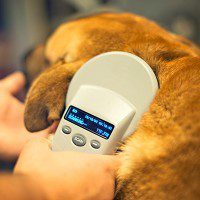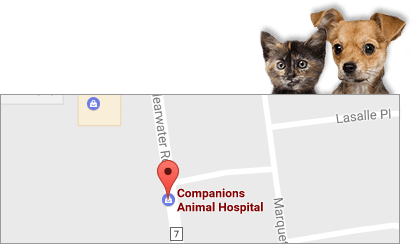 This summer there has already been a lot of news items about pets finding their way home because of microchips. Sometimes quickly, sometimes years down the road.
This summer there has already been a lot of news items about pets finding their way home because of microchips. Sometimes quickly, sometimes years down the road.
Maybe you have never heard of a microchip before or maybe you are concerned about possible side effects. A microchip is a small chip that is injected under the skin (sometimes into the muscle layer) that is about the size of a thin grain of rice.
This chip carries a number that is unique. It is NOT a GPS locator so unfortunately it won’t tell you your pet is now at our veterinary clinic in St. Cloud, MN or that it is in Clearwater or Sartell (at least not at this point!). When the chip is scanned the number pops up on the scanner window and you have that individual’s unique ID number. From that number you can find who the pet belongs to.
There is a big “IF” at the end of that last sentence because if the owner did not register the chip, there will be no information in the data base. It is absolutely CRITICAL to register your pet’s microchip if it is going to do what it is designed to do. In addition, make sure that if you move, have a new phone number or email, new emergency contact information etc. that all that is kept up-to-date as well. At Companions we do the registering for you so that you know it is all taken care of right away – saving you the hassle.
So, what are the benefits to microchipping? The obvious one is that if your pet is lost or stolen and then found by someone else, taken to a humane society, an animal control office or to a veterinarian, the pet is scanned, the chip found and you get your beloved family member home! Do you think it makes a difference? Well, one study definitely showed that it will help.
One study of more than 7,700 stray animals at animal shelters showed that dogs without microchips were returned to their owners 21.9% of the time, whereas microchipped dogs were returned to their owners 52.2% of the time. Cats without microchips were reunited with their owners only 1.8% of the time, whereas microchipped cats went back home 38.5% of the time. (Lord et al, JAVMA, July 15, 2009)
Those are much better odds!
Some companies, like Home Again have other benefits as well. They have “Lost Pet Specialists” that you can call 24/7 to help you through the process of finding your pet, they have local “Pet locators” that are alerted any time a pet is lost in their area so that they can help search, and, they have pet travel insurance that helps pay for the cost of getting your found pet back home. Some databases allow you to store medical information as well so for instance, if your pet is diabetic and needs daily medication, the people who find your pet will be alerted.
The pet does not need to be sedated or anesthetized to implant the chip; although we often do this at the time of spaying or neutering so they are under anesthesia. It is an injection so there is a brief moment of the needle entering the skin but once it is done most pets don’t even seem to react or care.
Those are the upsides, what are the downsides? Certain microchips cannot be read by all scanners. This has been a problem in the past but more and more universal scanners are around so that this risk is decreasing all the time. We have had a few times where a pet came in and the chip could not be read. If it is a chip we implanted the company will cover the cost to put in a new chip which is great. I think it is a good idea to have your pets chip scanned at its twice yearly exams just to make sure everything is in working order.
Other concerns are migrating microchips (it moves under the skin to a different location). There have been some reports of cancer at the site of a chip. In these 2 dogs (2 out of millions!) it could not be proven that the chip actually caused the cancer. The British Small Animal Veterinary Association (BSAVA) maintains a database of adverse reactions to microchips. The database, started in 1996 shows over 4 million animals have been microchipped. Believe it or not ONLY 391 adverse reactions have been reported. That’s a low number. Of these reactions, migration of the microchip is the most common problem reported. Other problems, such as failure of the microchip, hair loss, infection, swelling, and tumor formation, were reported in much lower numbers.
Overall – I would say the benefits FAR outweigh the risks. If you want more information check out our web page.












